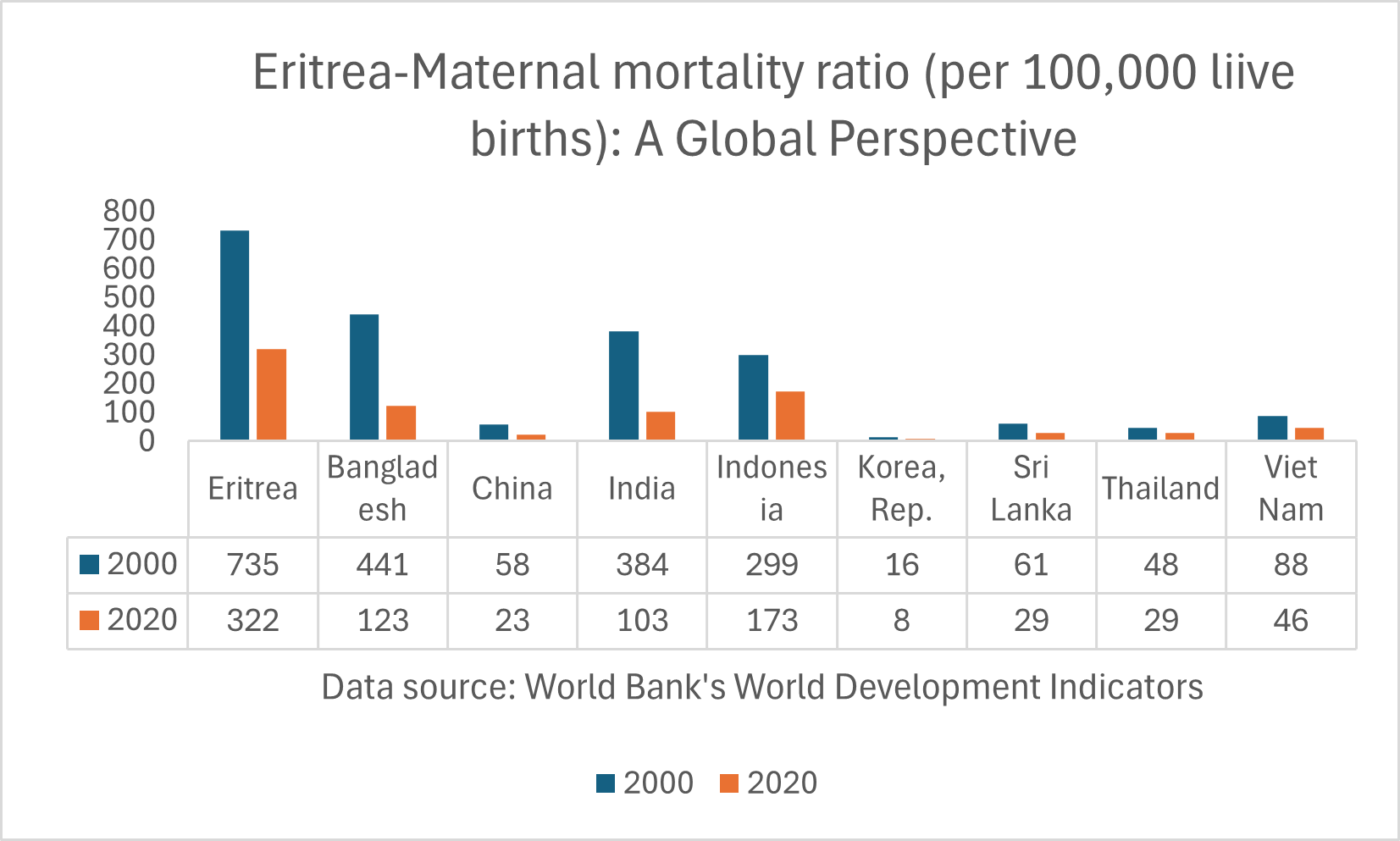
Eritrea
Country Flag Details
red isosceles triangle (based on the hoist side) dividing the flag into two right triangles; the upper triangle is green, the lower one is blue; a gold wreath encircling a gold olive branch is centered on the hoist side of the red triangle; green stands for the country’s agriculture economy, red signifies the blood shed in the fight for freedom, and blue symbolizes the bounty of the sea; the wreath-olive branch symbol is similar to that on the first flag of Eritrea from 1952; the shape of the red triangle broadly mimics the shape of the country
note: one of several flags where a prominent component of the design reflects the shape of the country; other such flags are those of Bosnia and Herzegovina, Brazil, and Vanuatu.
Background
After independence from Italian control and then UK oversight, the UN established Eritrea as an autonomous region within the Ethiopian federation in 1952. Ethiopian annexation sparked a 30-year conflict for independence that ended in 1991. Eritreans overwhelmingly approved independence in a 1993 referendum.
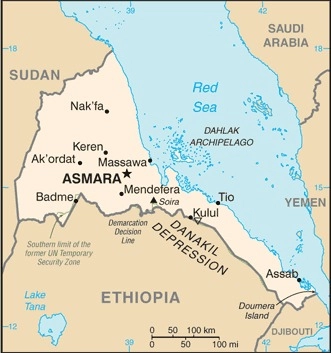
Geography
Area
total : 117,600 sq km
land: 101,000 sq km
water: 16,600 sq km
Climate
hot, dry desert strip along Red Sea coast; cooler and wetter in the central highlands (up to 61 cm of rainfall annually, heaviest June to September); semiarid in western hills and lowlands
Natural resources
gold, potash, zinc, copper, salt, possibly oil and natural gas, fish
People and Society
Population
total: 6,343,956
Ethnic groups
Tigrinya 50%, Tigre 30%, Saho 4%, Afar 4%, Kunama 4%, Bilen 3%, Hedareb/Beja 2%, Nara 2%, Rashaida 1% (2021 est.)
Languages
Tigrinya (official), Arabic (official), English (official), Tigre, Kunama, Afar, other Cushitic languages
Religions
Eritrean Orthodox, Roman Catholic, Evangelical Lutheran, Sunni Muslim
Population growth rate
1.12% (2024 est.)
Government
Government type
presidential republic
Capital name: Asmara
Executive branch
chief of state: President ISAIAS Afwerki (since 24 May 1993)
head of government: President ISAIAS Afwerki (since 8 June 1993)
Economy
Economic overview
largely agrarian economy with a significant mining sector; substantial fiscal surplus due to tight controls; high and vulnerable debts; increased Ethiopian trade and shared port usage decreasing prices; financial and economic data integrity challenges
Real GDP (purchasing power parity)
$9.702 billion (2017 est.)
$8.953 billion (2016 est.)
$8.791 billion (2015 est.)
Real GDP per capita
$1,600 (2017 est.)
$1,500 (2016 est.)
$1,500 (2015 est.)
Exports
$624.3 million (2017 est.)
$485.4 million (2016 est.)
Exports – partners
China 67%, UAE 26%, Philippines 5%, Italy 1%, Croatia 1% (2023)
Exports – commodities
copper ore, zinc ore, gold, garments, liquor (2023)
Imports
$1.127 billion (2017 est.)
$1.048 billion (2016 est.)
Imports – partners
China 32%, UAE 27%, Turkey 9%, USA 7%, Italy 5% (2023)
Imports – commodities
trucks, sorghum, construction vehicles, wheat flours, other foods (2023)

Explore structure by product group in 2023 (% of total exports) (UNCTAD)
The export structure of a country reflects the diversity, composition, and monetary value of its goods and services that are exchanged on the global stage, providing essential insights into the nation’s economic health, competitive standing, and developmental phase. In Eritrea, this export structure is predominantly centered around mineral resources, prominently featuring copper ore, zinc ore, and gold, which constitute a significant portion of its economic output. Unfortunately, there is a noticeable lack of diversification into other sectors, such as manufactured goods and agriculture, which limits the potential for broader economic growth. Additionally, Eritrea’s export markets are primarily focused on a select number of countries, with China and the United Arab Emirates being the main recipients of its exported goods, indicating a concentrated trade relationship that could benefit from further exploration of additional markets.
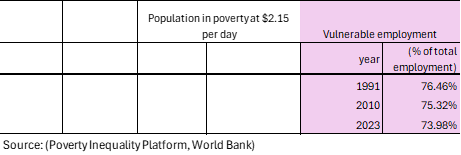
Vulnerable employment in Eritrea
IN 2023, 74 percent of the total employment in Eritrea was classified as vulnerable employment. Vulnerable employment represents a critical issue marked by insufficient job security, meager wages, and a glaring absence of essential social protections such as health insurance, pensions, or labor rights. This category predominantly encompasses Own-Account Workers—individuals who operate independently without employees, including street vendors and small-scale farmers—and Contributing Family Workers, who contribute to family enterprises or farms without formal compensation. The nature of these roles is often informal and precarious, exposing workers to heightened risks of economic shocks, exploitation, and persistent poverty. The ramifications of such employment extend far beyond the individual, adversely affecting families and communities while perpetuating cycles of instability and hardship that are exceedingly challenging to overcome.
Understandin poverty level significance at $2.15 per day
The poverty level at $2.15 per day (measured in 2017 purchasing power parity, or PPP) is a key global benchmark used by the World Bank to define extreme poverty in low-income countries. It indicates:
1. Basic Survival Threshold
• People living below $2.15 per day struggle to afford essential needs such as food, clean water, shelter, healthcare, and education.
2. Economic Underdevelopment
• A high percentage of a country’s population living below this threshold suggests low economic productivity, high unemployment, and weak social safety nets.
3. Inequality and Social Vulnerability
• It reflects deep income inequality and a lack of access to opportunities for upward mobility.
• People in this category are more vulnerable to shocks like food price increases, climate disasters, or health crises.
4. Policy Challenges
• Governments need targeted interventions such as social welfare programs, job creation, and improved access to education and healthcare to reduce poverty.
A country's export structure is a reflection of its level of development and productive capacities
The export structure of a country refers to the composition, diversity, and value of the goods and services it sells to other countries. It provides key insights into the country’s economic health, competitiveness, and level of development. Productive capacities of a country refer to its ability to produce goods and services efficiently and sustainably over time. These capacities are shaped by various factors, including human capital, natural resources, infrastructure, private sector, development, technology & innovation, institutions & governance, financial systems trade & market access.
Here’s what the export structure and productive capacities of a country typically indicate:
- Level of Economic Development
- Developed economies usually export high-value manufactured goods, technology, and services.
- Developing economies often rely on raw materials, agricultural products, or low-value manufactured goods.
- Industrial and Sectoral Strengths
- A strong presence of high-tech or industrial goods (e.g., machinery, electronics) suggests a well-developed manufacturing sector.
- A dominance of commodities (e.g., oil, minerals, agricultural products) indicates reliance on natural resources.
- Export Diversification
- A diverse export base (multiple industries) makes a country’s economy more stable and resilient to global price shocks.
- A concentrated export base (few key products) makes it vulnerable to market fluctuations.
- Trade Partnerships and Dependence
- If exports are heavily dependent on a single country or region, the economy is more exposed to geopolitical and trade risks.
- A wide range of trading partners indicates stronger global integration.
- Competitiveness and Value Addition
- Exporting mainly raw materials (e.g., crude oil instead of refined petroleum) suggests limited industrial processing capacity.
- A high share of finished and high-tech goods suggests strong value addition and competitiveness.
Eritrea-Sanitation
Eritrea – Proportion of population served with at least basic sanitation
In 2000, proportion of population served with at least basic sanitation for Eritrea was 8.3 %. The Proportion of population served with at least basic sanitation of Eritrea increased from 8.3 % in 2000 to 11.2 % in 2010, an absolute change of 2.9 percentage points (pp) between 2000 and 2010.
Eritrea- Proportion of urban population served with at least basic sanitation
In 2000, the proportion of urban population served with at least basic sanitation for Eritrea was 27.3 %. The proportion of urban population served with at least basic sanitation of Eritrea declined from 27.3% in 2000 to 22.9 in 2010, an absolute change of 4.4 pp between 2000 and 2010.
Eritrea – Proportion of rural population served with at least basic sanitation
In 2000, the proportion of rural population served with at least basic sanitation for Eritrea was 1.4%. The Proportion of rural population served with at least basic sanitation of Eritrea increased from 1.4 % in 2000 to 4.9% in 2010, an absolute change of 3.5 pp between 2000 and 2010
Eritrea – Proportion of total population served with at least basic sanitation: A Global Perspective
The ongoing shortage of safe sanitation represents a critical challenge that demands immediate collective action, resulting in preventable deaths for hundreds of thousands each year and highlighting a significant public health crisis that requires our attention. Access to adequate sanitation is not merely a necessity; it is a fundamental human right that should be guaranteed for everyone. In 2000, nearly 88 percent of Eritrea’s population faced the severe consequences of inadequate sanitation, contrasting sharply with countries like Malaysia and Thailand, where only 7 percent, and 8 percent, respectively lacked these essential services in 2000. With the global average of individuals without proper sanitation at about 6 percent, there is an urgent need for collaborative efforts to improve sanitation access in underserved regions of Sub-Saharan Africa, where the health and dignity of many are at risk and our shared responsibility to uphold human rights is evident.
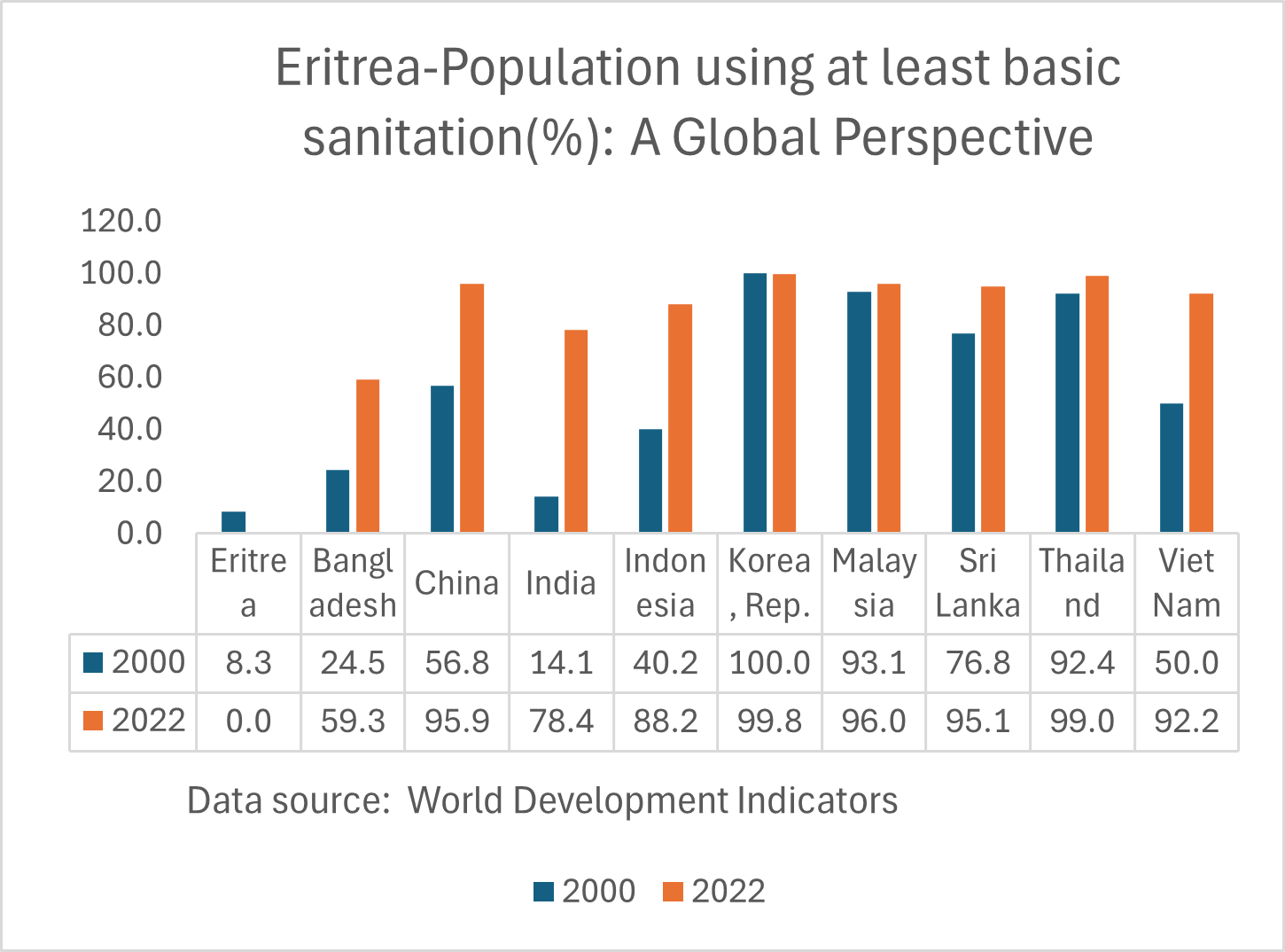
Eritrea – Proportion of rural population served with at least basic sanitation: A Global Perspective
Eritrea is grappling with a severe public health crisis, as a staggering 99 percent of its rural population lacked basic sanitation facilities in 2000. This situation sharply contrasts with countries like Malaysia and Thailand, where the rural population without access is significantly lower at 9 and 6 percent, respectively, in 2000. The dire state of sanitation results in a heartbreaking loss of life each year and exacerbates existing health issues, emphasizing the need for urgent intervention. Recognizing safe sanitation as a fundamental human right is crucial for restoring dignity and improving the well-being of individuals in these communities. We must advocate for this right across Sub-Saharan Africa, building partnerships to tackle this critical issue collaboratively. By uniting our efforts, we can make meaningful progress in enhancing living conditions and health outcomes, fostering a healthier and more equitable future for all.
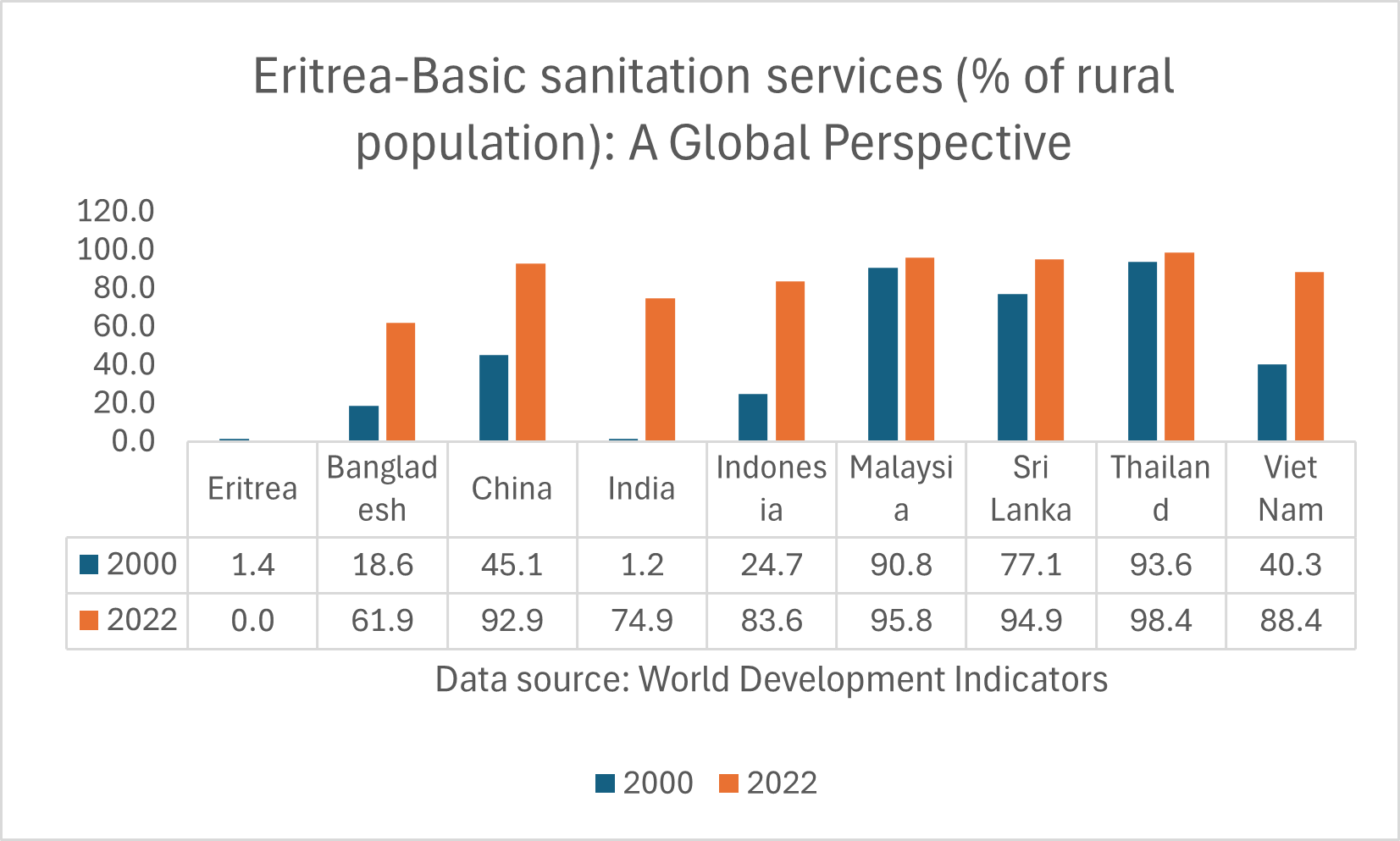
Eritrea-Water Supply
Eritrea – Proportion of total population served with at least basic water
In 2010, the proportion of population served with at least basic water for Eritrea was 50.0%. The proportion of population served with at least basic water of Eritrea increased from 46.8 % in 2000 to 50.0 % in 2010 an absolute change of 3.2 pp between 2000 and 2010.
Eritrea – Proportion of urban population served with at least basic water
In 2010, the proportion of urban population served with at least basic water for Eritrea was 89.9 %. The proportion of urban population served with at least basic water in Eritrea slightly declined from 90.5 % in 200o to 89.9 % in 2010 an absolute change of 0.6 pp between 2000 and 2010.
Eritrea – Proportion of rural population with at least basic water
In 2010, the proportion of rural population served with at least basic water for Eritrea was 28.3%. The proportion of the rural population served with at least basic water in Eritrea declined from 31.0 % in 2000 to 28.3 % in 2010 an absolute change of 2.7 pp between 2000 and 2010.
Eritrea – Proportion of total population served with at least basic drinking water: A Global Perspective
Access to safe drinking water is a basic human need and an important right that affects people’s dignity and well-being. In the year 2000, around 2 million Eritreans, which is more than half of the population, did not have access to essential drinking water, showing a serious public health problem. In comparison, 97 percent of Malaysia’s population and 94 percent of Thailand’s population had reliable access to safe drinking water in 2000, highlighting the significant progress made and the stark differences faced by communities in Sub-Saharan Africa. Many people in these communities still struggle without this vital resource, which highlights the urgent need for action to provide this fundamental human necessity that impacts the health and future of millions in Sub-Saharan Africa.

Eritrea – Proportion of rural population served with at least basic water: A Global Perspective
In 2000, 69 percent of the rural population in Eritrea, approximately 1.6 million people, lacked access to safe drinking water, highlighting the urgent need for improved governance in Sub-Saharan Africa. In contrast, 93 percent of rural Malaysians and 94 percent of rural Bangladeshis had access to clean water in 2000, underscoring the need for focused efforts to enhance living conditions in rural communities across Sub-Saharan Africa. By prioritizing access to essential resources like clean drinking water, we can inspire hope and drive meaningful progress, paving the way for a fairer future where all communities achieve basic human rights and dignity.
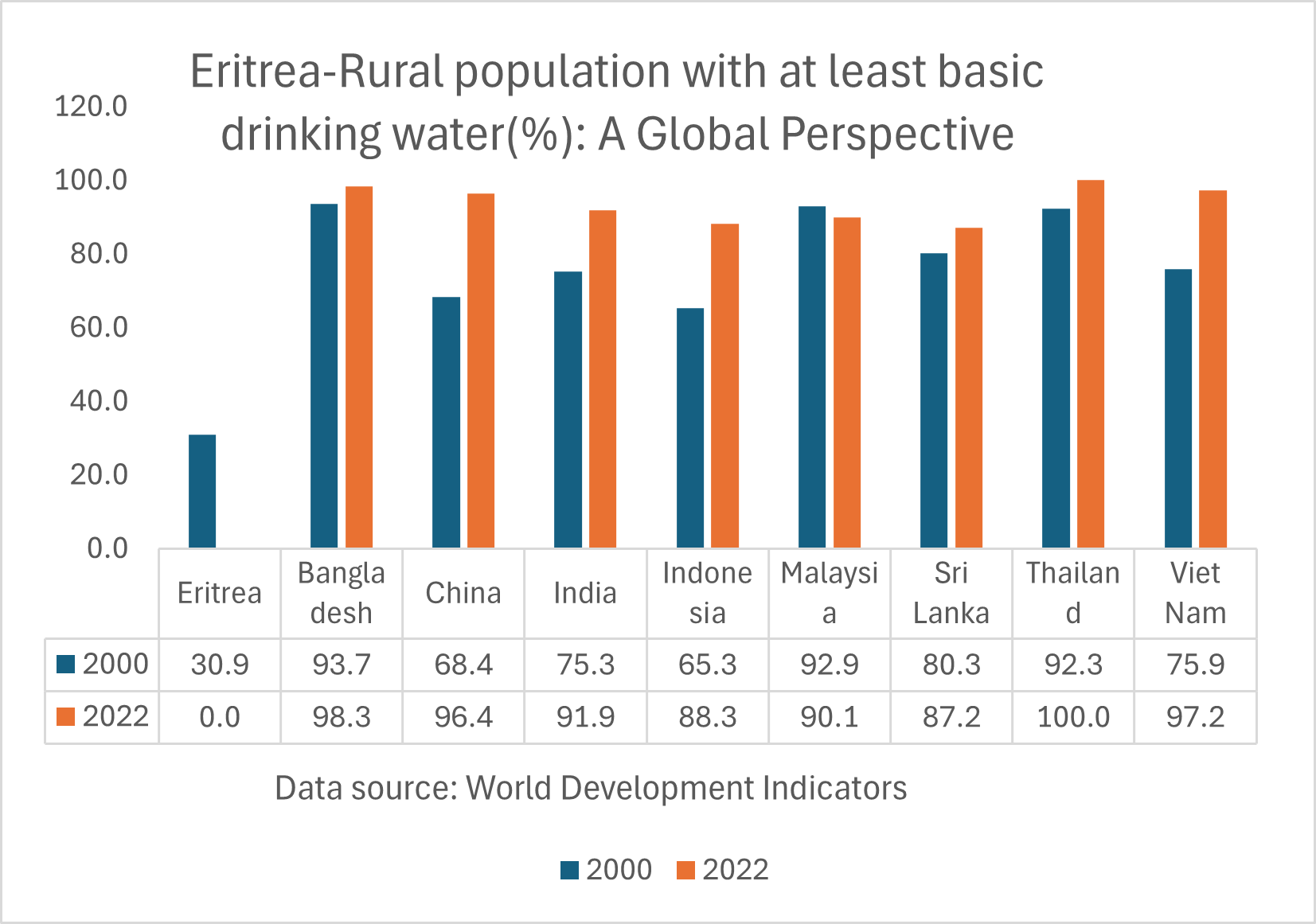
Eritrea-Access to Electricity
Eritrea-Access to electricity (% of population)
In 2022, The proportion of population with access to electricity for Eritrea was 55.4 %. The proportion of population with access to electricity of Eritrea increased from 29.3% in 2000 to 55.4% in 2022, an absolute change of 26.1 between 2000 and 2022.
Eritrea-Access to electricity (% urban population)
In 2022, The proportion of urban population with access to electricity for Eritrea was 75.5%. The proportion of urban population with access to electricity of Eritrea declined from 79.2% % in 2000 to 75.5% in 2022, an absolute change of 3.7 pp between 2000 and 2022.
Eritrea-Access to electricity (% of rural population)
In 2022, The proportion of rural population with access to electricity for Eritrea was 36%. The proportion of the rural population with access to electricity of Eritrea increased from 11.2 % in 2000 to 36% in 2022, an absolute change of 24.8 pp between 2000 and 2022.
Eritrea-Total population with access to electricity (% of population): A Global Perspective
In 2022, a concerning 45 percent of the population in Eritrea had no access to electricity, affecting more than 1.6 million people who need this vital service for everyday life. This situation is alarming when compared to countries like Vietnam, Thailand, Sri Lanka, and Malaysia, which have achieved universal electricity access. It highlights the urgent need for effective solutions across Sub-Saharan Africa to improve living conditions for its people. The absence of reliable electricity is not just a small issue; it is a major barrier to development, health, education, and economic opportunities, which are essential for raising living standards and creating hope for a better future in countries like Eritrea.
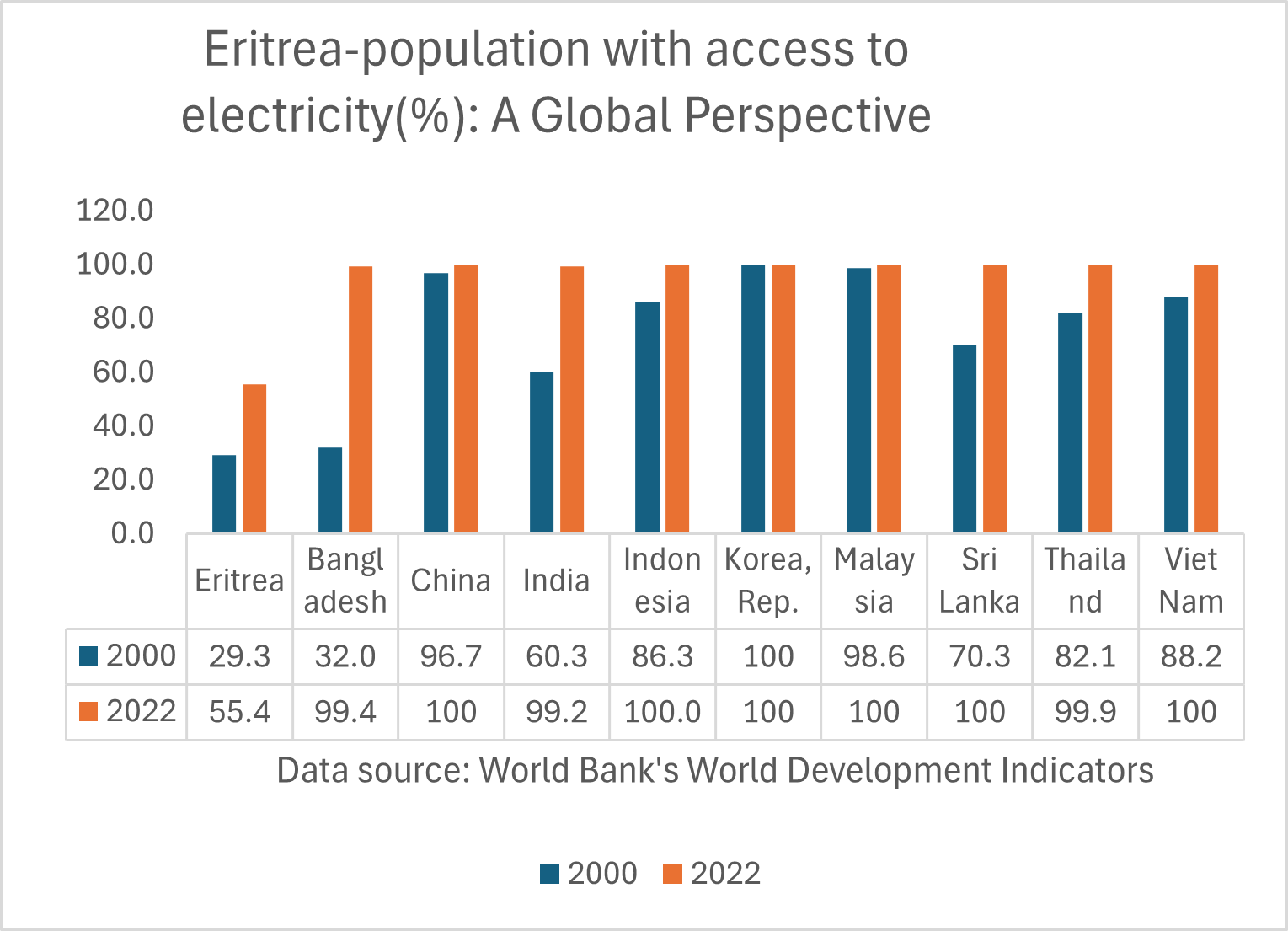
Eritrea- Rural population with access to electricity (% of rural population): A Global Perspective
In 2022, 64 percent of Eritrea’s rural population, approximately 1.4 million people, lived without electricity, starkly contrasting with countries like Vietnam, Thailand, and Sri Lanka where all rural residents have access to this essential resource. Even India and Bangladesh report that 99 percent of their rural populations enjoy reliable electricity, highlighting the urgent need for transformative reforms across Sub-Saharan Africa. These statistics reveal a critical requirement for targeted strategies that address the specific challenges faced by rural communities in the region, ensuring they gain access to dependable electricity and the resources needed to thrive for a sustainable future.
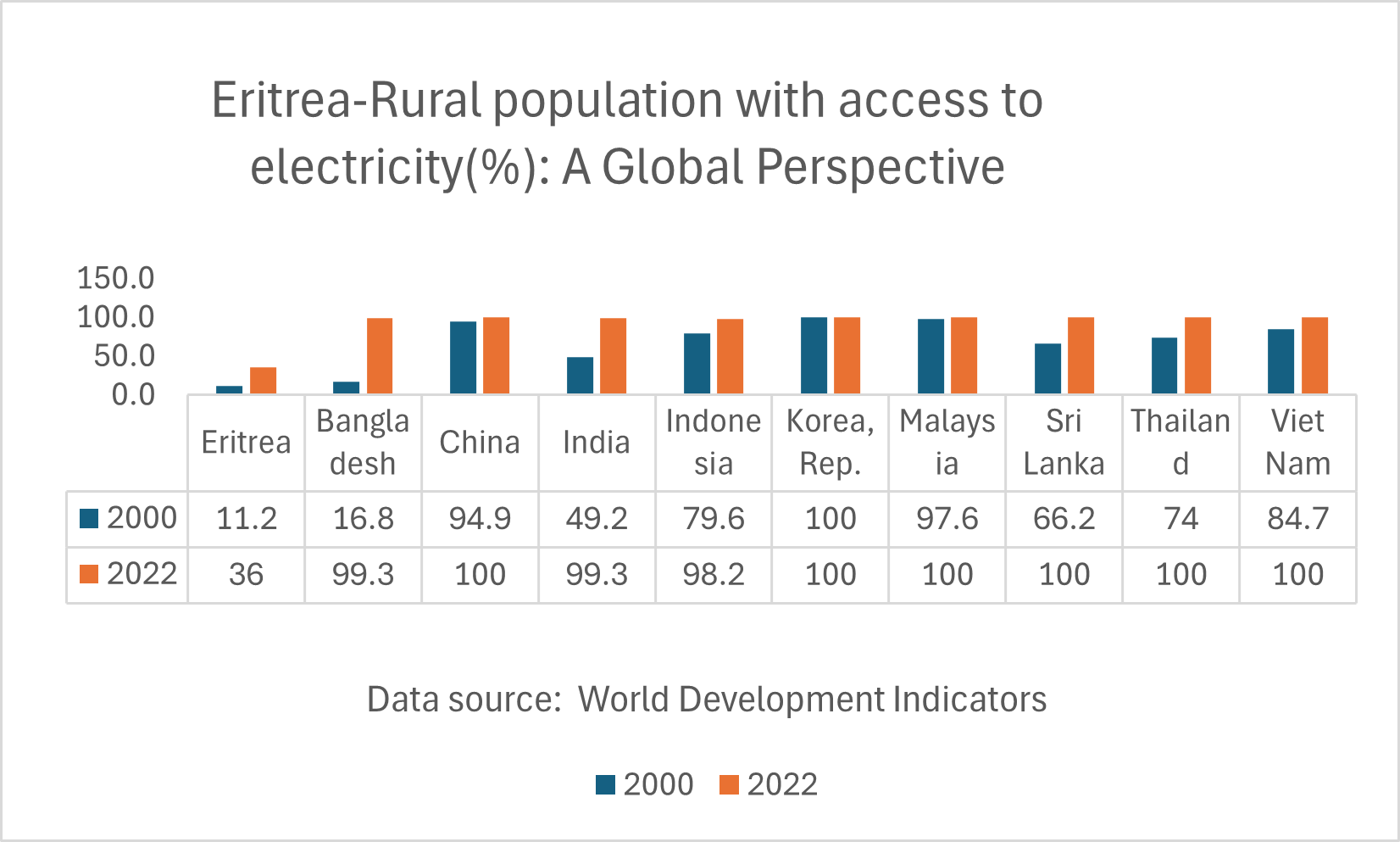
Eritrea: Health outcomes
Eritrea-Life expectancy: A Global Perspective
Eritrea’s life expectancy trends over the past seventy years highlight significant improvements in global health alongside ongoing regional challenges. The global average life expectancy for newborns rose from 47 years in 1950 to 71 years in 2021, yet many Sub-Saharan African nations, including Eritrea, continue to face serious obstacles. Eritrea’s life expectancy increased from 38 years in 1960 to 67 years in 2022, showcasing the resilience of its people amid persistent difficulties. In contrast, countries like South Korea have seen life expectancy grow from 54 years in 1960 to 83 years in 2022, and the Maldives from 39 years in 1960 to 81 years in 2022. The lower life expectancy in several sub-Saharan nations reminds us of the challenges, including chronic poverty and inadequate healthcare, emphasizing the pressing need for compassionate solutions to foster a sustainable and equitable future for these communities.
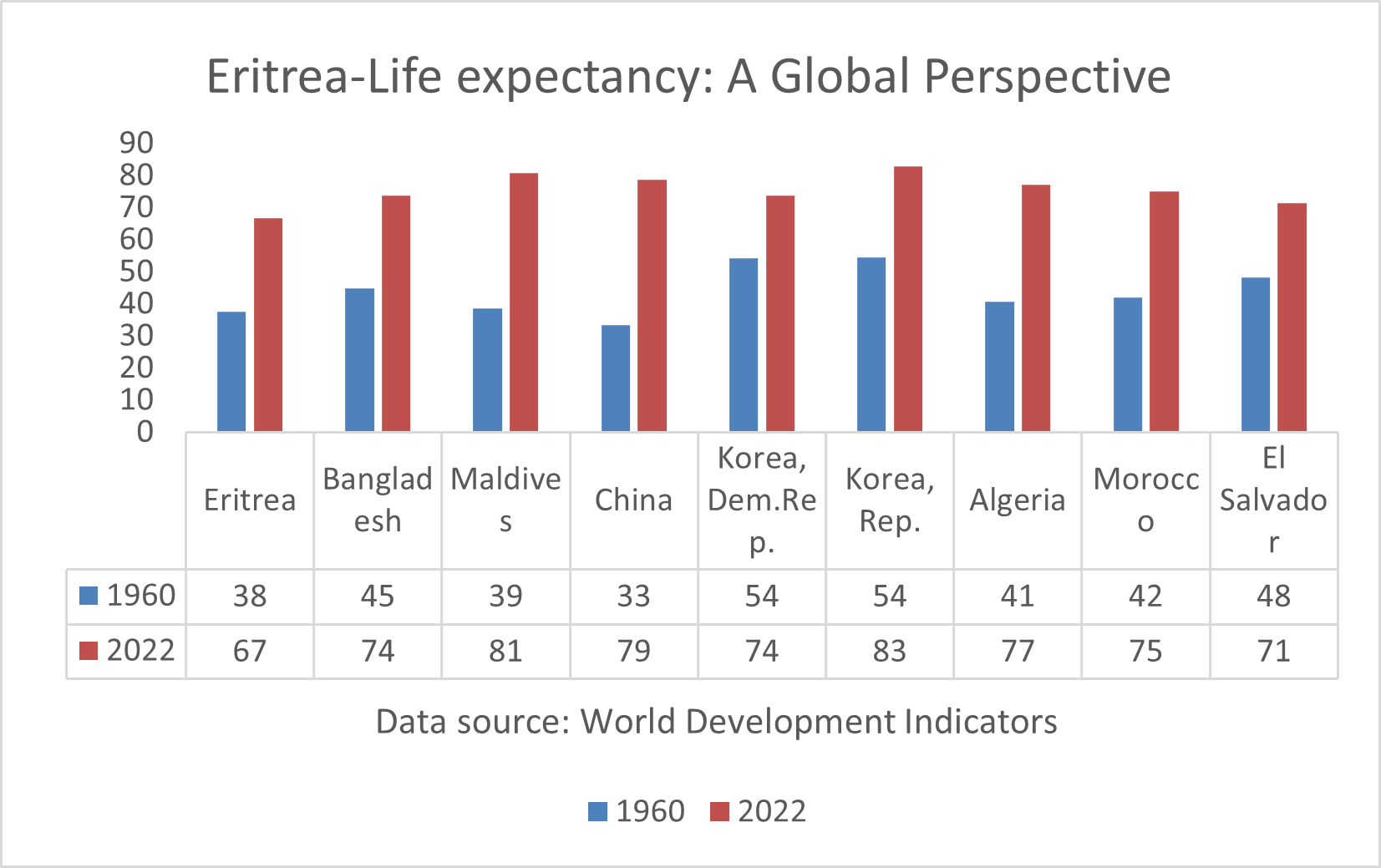
Eritrea-Under-5 mortality rate (per 1000 live births): A Global Perspective
Eritrea’s under-five mortality rate reflects a broader global decline in child mortality since 1950, driven by improved living standards and access to healthcare and nutrition. In wealthier nations, child mortality has dropped below 4 percent, demonstrating the effectiveness of their healthcare systems. While many developing countries have made strides, progress in Sub-Saharan Africa remains slow. Eritrea has reduced its under-five mortality rate from 194 in 1980 to 37 in 2022, similar to Bangladesh’s drop from 206 to 29 and India’s decline from 169 to 29 in the same period. These statistics highlight the ongoing challenges in Sub-Saharan Africa due to inadequate healthcare systems and emphasize the need for comprehensive governance reforms to reduce child mortality and improve health outcomes, underscoring the importance of international cooperation and investment in sustainable health initiatives.
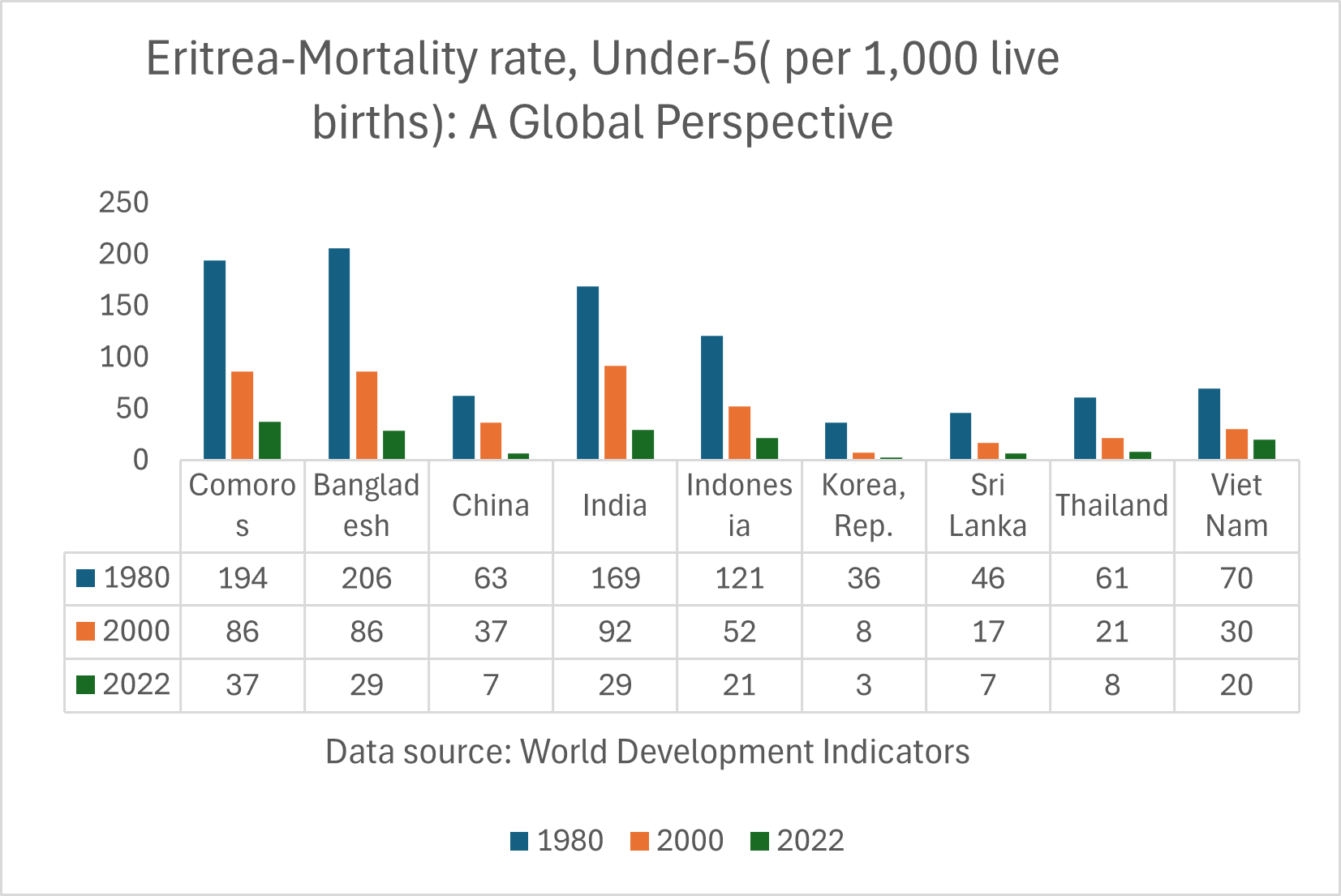
Eritrea-Maternal mortality ratio (per 100,000 live births): A Global Perspective
Eritrea’s maternal mortality highlights a critical healthcare crisis affecting mothers and their families, necessitating urgent improvements in care and support. While the maternal mortality ratio has decreased from 735 in 2000 to 322 in 2020. In comparison, countries like Bangladesh and India have achieved substantial reductions, with rates falling from 441 to 123 and 384 to 103, respectively. These disparities reveal a concerning reality where many mothers lack access to essential care, compounded by high birth rates and ongoing maternal health issues demanding immediate action in communities across Sub-Saharan Africa.
